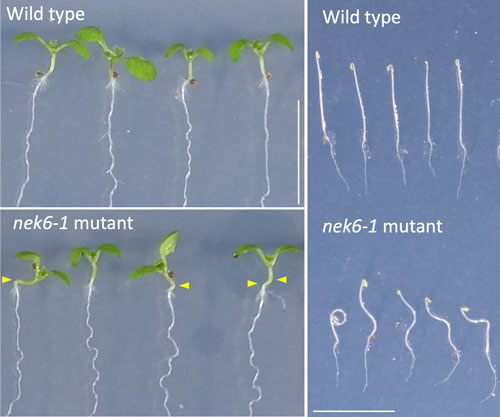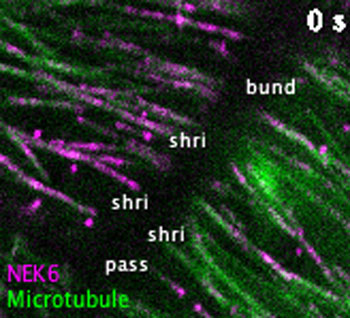All living organisms are changing shape, notably through their development. Proprioception is the perception of self, i.e. the deformation of one’s own body. It was originally defined for locomotion in animals, where stretch sensors in muscle inform the brain on limb movement. Although they do not have a central nervous system, the concept of proprioception has been extended to plants. Indeed, plants can also sense their own elongation and bending, notably through the perception of associated changes in intensity and direction of mechanical forces (1). Yet, the associated molecular mechanism remains mysterious (2). Proprioception has been proposed to add robustness to shape changes, but this remains debated (3). Here, we identified that the NEK6 tubulin kinase (4),(5) acts as a negative regulator of proprioception in plants through a modulation of the cell response to forces.

Figure 1: Phenotype of WT and NEK6 mutant: note the distorted shape of the mutant.
To resist mechanical stress, plant cells guide the deposition of stiff cellulose microfibrils in their cell wall, in the main direction of mechanical stress. This process involves microtubules that align with such forces (6). We found that NEK6 preferentially depolymerizes the microtubules that are best aligned with mechanical stress. NEK6-defective plants become hyper-proprioceptive: they perceive their own shape and growth too much. This leads to a stop-and-go growth pattern, almost like an inexperienced car driver who would accelerate and break too fast, being overly sensitive to the speed of their own car. NEK6-defective plants also display other defects such as excess of curvature when responding to gravity: they bend their stem too much, even forming a full circle in the end.

Figure 2: NEK6 (purple) and microtubule (green) at a plant cell edge: note the NEK6-dependent microtubule dynamics.
This study provides a key advance in our understanding on how plants monitor their own shape. It appears that proprioception is not maximal in normal plants. In other words, we demonstrate that proprioception needs to be curbed to avoid the defects that emerge in the absence of NEK6. We propose that a suboptimal response to the plant’s own deformation, i.e. a form of inefficiency, is required to smooth plant growth. In other words, delays are helping the plant not to be too sensitive to shape changes, and to channel its elongation. Our study also unravels a novel player of the plant mechanotransduction pathway, in the form of a negative regulator of the microtubule response to stress. The support of HFSP in this endeavor has been instrumental, and this study is also a seed for further research on the role of mechanical forces in other processes, such as cell division plane orientation.


































